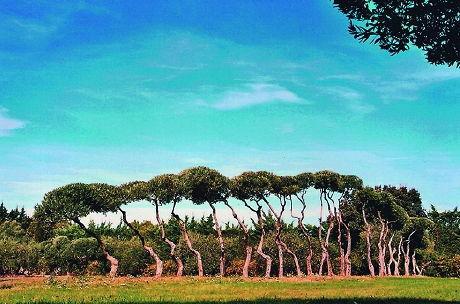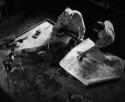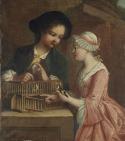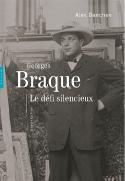Art Of The Day Weekly
#343 - from 24 April 2014 to 30 April 2014

Carte verte Marc Nucera dans le parc du Goualoup et Parc Historique : © M. Nucera (Festival international des jardins in Chaumont-sur-Loire)
iN THE AIR
The garden of all sins
CHAUMONT-SUR-LOIRE – Every spring this annual event, the festival of gardens of Chaumont, presents ephemeral compositions on a specific theme. Since 1992, over 600 gardens have been designed by teams that include landscape artists, artists, historians, philosophers, sociologists, musicians, and more. For 2014, the participants shall answer a biblical invitation on capital sins. It is moderated by Paul Valéry’s expression, according to which “the perfection of what is just is due to the good composition of the seven capital sins”. The re-interpretation of a card from hell which Lorenzo de' Medici commissioned to Botticelli, the mention of saint Thomas Aquinas and Jean-Jacques Rousseau, patches of damned flowers (psychotropic and narcotics) or unfortunate love stories of three volcanoes in the Maori culture: gardens are as much food for thought as they are a feast for the eyes. The landscape can combine with art (an ambitious program of installations since 2008) and an environment-oriented turn (night watering by micro-dispersion, manual elimination of weeds, vegetable recycling, or natural mulch). Those who enjoy contemplating these wonders alone now pay the price; indeed, since 2008, attendance has gone from 200,000 to 400,000 visitors.
• Festival international des jardins at the Domaine de Chaumont-sur-Loire, from 25 April to 2 November 2014.
EXHIBITIONS

A team of camouflage experts at work at Fort Belvoir, Virginia, USA. Illustration in Modern Camouflage by Robert P. Breckenridge © DR
War and architecture
PARIS – One often feels that wars automatically put architects to rest. It was exactly the contrary during World War II, according to the curator of this exhibition, Jean-Louis Cohen. The dimension of the conflict made it mandatory to build different facilities at an increased speed, whether it was lines of fortifications, weapon factories, shelters for the civilians, dismountable barracks, military headquarters, prisoner camps, as well as the Nazi extermination camps. War favoured the search for innovating materials, and even before the end of hostilities, it pushed some to work on reconstruction. By pushing this thought further, one could almost demonstrate that all architecture after the war is simply the application of this research in time of peace. The exhibition looks into destructions (the specific assessment written up by Doxiadis on the damage caused to Greece) as well as into the solutions of construction in an autocratic economy (the Murondin houses by Le Corbusier, who flirted with the regime in Vichy) or the iconic projects of the time, such as the Pentagone in Washington D.C.
• Architecture en uniforme, projeter et construire pour la Seconde Guerre mondiale at the Cité de l’architecture et du patrimoine, from 24 April to 8 Septembre 2014.
Lucio Fontana, beyond the slits
PARIS – He is known around the world as the man with the slit canvases. But in a career that spanned over half a century, Lucio Fontana (1899-1968) had the time to experiment in many other fields, in polychrome ceramics and sculpture for example. With 200 pieces, the exhibition gives us enough space to get a more complete idea of an artist’s work that has too often been caricatured.
• Lucio Fontana at the musée d’Art moderne de la Ville de Paris, from 25 April to 24 August 2014.
All of Tschumi
PARIS – He is the author of the follies in the Park of la Villette, of the museum of the Greek Acropolis, the headquarters of Vacheron Constantin or the recent zoo in Vincennes. But Bernard Tschumi (born in 1944), is not only an architect, but a theorist as well. The Centre Pompidou, with some 350 objects – drawings, collages, models –shows his polymorphic work, influenced by movies and contemporary art.
• Bernard Tschumi at the Centre Pompidou, from 30 April to 28 July 2014.
AUCTIONS

Lot 24, Gaspard Gresly (L'Isle-sur-le-Doubs 1712-1756 Besançon), The birdcage. Oil on canvas, 81.2 x 65 cm. Estimate: €2000-3000.
French style
PARIS – What is French taste? How can we define it? Christie’s has done it by presenting a special selection. These are not masterpieces but rather pieces of decorative art with a perfect technique, that prove a know-how that has been transmitted from one generation to the next. In defining taste, the origin is often fundamental: the way of putting works of art side by side is not by chance but rather a well-thought out choice, by a real connoisseur, in this case Arthur Georges Veil-Picard (1854-1944). He knew how to create suspense for the greatest buyers of his time– Nathan Wildenstein, Jacques Seligmann or the Rothschilds -, or Arturo López-Willshaw, a great patron from Versailles in the period following the war. This particular selection includes miniatures by Ritt and Hall, vases from the time of Louis XV, céladon furniture of Jean-Baptiste III Lelarge, a wardrobe by Mathieu Guillaume Cramer in rose wood marquetry, all testimonials from the beginning of Louis XVI’s reign, but there are also snuff boxes decorated with gouaches, Meissen porcelain ink bottles, gilded bronze brackets and light fixtures.
• Le goût français : art décoratif du XVIIe au XIXe siècle at Christie’s on 29 April 2014
ARTIST OF THE WEEK
Vincent Fournier and untouchable species
We all complain about the inevitable loss of certain animal and plant species, caused by human predation. But shouldn’t science, with all the progress made, allow us tomorrow to create the species we wish to enjoy? Based on this terrifying idea, Vincent Fournier (born in 1970) decided to get a step ahead. By using the resources of technique, from infographics to retouching photographs, but most of all with a good background inherited from Dadaism and Surrealism, he brings certain improvements to the existing species. In order to face the warming up of the planet, he equips ibis with metal legs, better adapted to the burning sand. His beetle, tired of getting lost in the under-growth, never goes out without his GPS. As for the falsely charming dragonfly, actually one of the greatest meat eaters in the world, capable of eating her own weight in meat, ten-fold at least, she has her own pollution detector. She only wants to eat organic food.
• Vincent Fournier is be in exhibited at Quai n°1 at Vevey (Switzerland), from 30 April to 7 June 2014.
OPENINGS OF THE WEEK

BOOKS
The Braque mystery
Who was Braque? Even though he was one of the sacred monsters of 20th century art, the question is worth asking given the way he contributed to keep a veil of mystery over his private life. We actually know very little about his love affairs, except for a love story with Marie Laurencin, and his family is incredibly transparent. As his dear friends Ponge, Leymarie or Paulhan pointed out, his life held spicy anecdotes, contrary to that of Picasso. It was already a miracle that his life did not end on his thirtieth birthday, 13 May 1915! It was then that he was abandoned on the battle field of the Somme, shelled, which made all consider him dead. He was born in Argenteuil, grew up in the Havre where his father had his business, but made Normandy his region of adoption. His seriousness and his silence allowed him to survive in face of the power of someone like Picasso, his exact contemporary. This fluid biography, written by an outsider of the art world (Danchev is a professor in international relations at the University of Nottingham), reminds us that Braque cannot be reduced to being the inventor –together with Picasso-of Cubism between 1907 and 1912, and later the pioneer of collages (before Picasso). Discreet, with true friends such as Malraux and Aimé Maeght, he went on to live for another half a century, up to his death in 1963, leaving a long trace with his numerous Oiseaux, the landscapes of his later years and the ceiling of the Louvre (1953).
• Georges Braque, le défi silencieux, by Alex Danchev, Hazan, 2013, 366 p. €32


